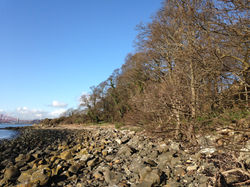Dandelion Feeding Stations
A few days ago some of you have noticed the posting by Plantlife trying to get people to appreciate the humble Dandelion. In this recent sunny weather I took an opportunity to see what might be making use of any Dandelions in our wildflower bank beside the steps. The first thing that was noticeable was that there were quite a lot of small bees flying back and forth over the lower part of the bank. Some were then resting in the sun to warm up while several were visiting Dandelion flowers to bury their faces deep into the flower to access the nectar.



These were not small Honey bees, but mining bees freshly emerged from their tunnels in the sandy soil which had been provisioned with pollen and nectar by last summer’s adults. As larvae they had consumed this food supply and pupated to await the spring warmth before making their way to the surface as new adults. A probable identity is that they are Chocolate Mining Bees (Andrena scotica), known to be present in this area and recorded by Ali Shuttleworth from this 1km square.

The soil at the back of the areas that were planted with some of the plug plants in December 2017 make an excellent area for nesting and there will no doubt be more tunnels being provisioned for the next generation as the year progresses, . Apart from visiting Dandelions, these bees are important pollinators of some of the fruit trees, so local plum crops may, in part, owe their bounty to these solitary bees, and this afternoon some of these mining bees along with some bumblebees were visiting the open flowers of the plum tree in my garden, so there are probably colonies elsewhere in the woodland or gardens.
It is good to see that the management of this wildflower bank is providing an environment to provide a healthy population of these pollinating insects.

They were not the only insects making use of Dandelion pollen and nectar. There were also the occasional Hoverflies on the flowers, feeding directly on the pollen.

There was other wildlife to be seen around the flower bank. A shiny 7-spot ladybird was setting off to look for aphids to eat, and a Small Tortoiseshell butterfly flew past, though it didn’t settle long enough for a photo. They too make use of Dandelions to replenish their energy reserves after a winter spent in hibernation, as shown in this photo taken in 2015.

Only one bumblebee was seen, a newly emerged Common Carder queen, but with the abundance of White Dead-nettle on the bank she did not need to visit Dandelion flowers.
An interesting sighting was an insect that looked like a diminutive wasp, but was almost certainly one of the cleptoparasitic (food stealing parasite) solitary bees, possibly Gooden’s Nomad Bee (Nomada goodeniana). It was also using the Dandelion flowers to get some sugary nectar. These search for the tunnels containing the cells of mining bees, freshly provisioned with pollen and nectar, and lay their eggs on the food store. Their larvae then use the food that had been collected by the host mining bee, for their own development.


From this brief look, it was good to see that our managed wildflower bank was providing for a good diversity of insect life. And there will be more to see as the year progresses.





























